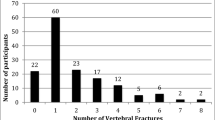Abstract
Background and aims: The occiput-wall distance (OWD), a measure of kyphosis, has been associated with postural instability, osteoporosis, disability and depression. The association between OWD and measures of physical performance was evaluated. Methods: Data from the Invecchiare in Chianti (InCHIANTI) study on home-dwelling people were used. People younger than 65 years and with overt disability at baseline assessment were excluded. The sample population was divided into three groups according to the OWD distribution (1st quartile: short OWD; 2nd and 3rd quartiles: medium OWD; 4th quartile: long OWD). Performance scores were expressed as the percentage of the best performance in this population. Results: 783 persons (55% women) were studied. The mean age for men was 73.8 (SD 6.34) and 75.0 (SD 6.85) for women. In men, a longer OWD was associated with reduced balance and walking speed, but not with impaired performance at the chair standing test. Overall, the association between increased OWD and reduced physical function was weak. In women, OWD was associated with a reduced walking speed, expressed as a percentage of the best performance (mean [SD]: 77% [12], 72% [14], 66% [15] in short, medium and long OWD groups, respectively), and impaired balance (mean [SD]: 97% [11], 95% [13], 90% [21] for short, medium and long OWD groups, respectively). Conclusions: Our findings suggest that OWD is an easily measurable marker of poor physical function in women. Further research should verify whether OWD predicts incident disability.
Similar content being viewed by others
References
Tribus CB. Scheuermann’s kyphosis in adolescents and adults: diagnosis and management. J Am Acad Orthop Surg 1998; 6: 36–43.
Balzini L, Vannucchi L, Benvenuti F, et al. Clinical characteristics of flexed posture in elderly women. J Am Geriatr Soc 2003; 51: 1419–26.
Di Bari M, Chiarlone M, Matteuzzi D, et al. Thoracic kyphosis and ventilatory dysfunction in unselected older persons: an epidemiological study in Dicomano, Italy. J Am Geriatr Soc 2004; 52: 909–15.
Kado DM, Huang MH, Barrett-Connor E, Greendale GA. Hyperkyphotic posture and poor physical functional ability in older community-dwelling men and women: the Rancho Bernardo study. J Gerontol 2005; 60: 633–7.
Ryan SD, Fried LP. The impact of kyphosis on daily functioning. J Am Geriatr Soc 1997; 45: 1479–86.
Guralnik JM, Ferrucci L, Pieper CF, et al. Lower extremity function and subsequent disability: consistency across studies, predictive models, and value of gait speed alone compared with the short physical performance battery. J Gerontol 2000; 55: M221–31.
Guralnik JM, Ferrucci L, Simonsick EM, Salive ME, Wallace RB. Lower-extremity function in persons over the age of 70 years as a predictor of subsequent disability. N Engl J Med 1995; 332: 556–62.
Onder G, Penninx BWJH, Lapuerta P, et al. Change in physical performance over time in older women: the Women’s Health and Aging Study. J Gerontol 2002; 57: M289–93.
Radloff LS. The CES-D scale: a self-report depression scale for research in the general population. Appl Psychol Meas 1977; 1: 385–401.
Parikh RM, Eden DT, Price TR, Robinson RG. The sensitivity and specificity of the Center for Epidemiologic Studies Depression Scale in screening for post-stroke depression. Int J Psychiatry Med 1988; 18: 169–81.
Louis O, Boulpaep F, Willnecker J, Van den Winkel P, Osteaux M. Cortical mineral content of the radius assessed by peripheral QCT predicts compressive strength on biomechanical testing. Bone 1995; 16: 375–9.
Chow RK, Harrison JE. Relationship of kyphosis to physical fitness and bone mass in post-menopausal women. Am J Phys Med 1987; 66: 219–27.
Sinaki M, Brey RH, Hughes CA, Larson DR, Kaufman KR. Balance disorder and increased risk of falls in osteoporosis and kyphosis: significance of kyphotic posture and muscle strength. Osteoporos Int 2005; 16: 1004–10.
Fried LP, Tangen CM, Walston J, et al. Frailty in older adults: evidence for a phenotype. J Gerontol 2001; 56: M146–56.
Metter EJ, Conwit R, Tobin J, Fozard JL. Age-associated loss of power and strength in the upper extremities in women and men. J Gerontol 1997; 52: B267–76.
Phillips SK, Rook KM, Siddle NC, Bruce SA, Woledge RC. Muscle weakness in women occurs at an earlier age than in men, but strength is preserved by hormone replacement therapy. Clin Sci (Lond) 1993; 84: 95–8.
Lamberts SW, van den Beld AW, van der Lely AJ. The endocrinology of aging. Science 1997; 278: 419–24.
O’Connor KG, Tobin JD, Harman SM, et al. Serum levels of insulin-like growth factor-I are related to age and not to body composition in healthy women and men. J Gerontol 1998; 53: M176–82.
Van Cauter E, Leproult R, Kupfer DJ. Effects of gender and age on the levels and circadian rhythmicity of plasma cortisol. J Clin Endocrinol Metab 1996; 81: 2468–73.
Albrecht AE, Hartmann BW, Scholten C, Huber JC, Kalinowska W, Zielinski CC. Effect of estrogen replacement therapy on natural killer cell activity in postmenopausal women. Maturitas 1996; 25: 217–22.
Kanda N, Tsuchida T, Tamaki K. Testosterone inhibits immunoglobulin production by human peripheral blood mononuclear cells. Clin Exp Immunol 1996; 106: 410–5.
Hazzard WR. The gender differential in longevity. In Hazzard WR, Bierman EL, Blass JP, Ettinger WHJ, Halter JB, eds. Principles of Geriatric Medicine and Gerontology. New York, NY: McGraw-Hill, 1994: 37–47.
Lynn SG, Sinaki M, Westerlind KC. Balance characteristics of persons with osteoporosis. Arch Phys Med Rehabil 1997; 78: 273–7.
O’Brien K, Culham E, Pickles B. Balance and skeletal alignment in a group of elderly female fallers and nonfallers. J Gerontol 1997; 52: B221–6.
Tinetti ME. Preventing falls in elderly persons. N Engl J Med 2003; 348: 42–9.
de Rekeneire N, Visser M, Peila R, et al. Is a fall just a fall: correlates of falling in healthy older persons. the health, aging and body composition study. J Am Geriatr Soc 2003; 51: 841–6.
Author information
Authors and Affiliations
Corresponding author
Rights and permissions
About this article
Cite this article
Antonelli-Incalzi, R., Pedone, C., Cesari, M. et al. Relationship between the occiput-wall distance and physical performance in the elderly: a cross sectional study. Aging Clin Exp Res 19, 207–212 (2007). https://doi.org/10.1007/BF03324691
Received:
Accepted:
Published:
Issue Date:
DOI: https://doi.org/10.1007/BF03324691




